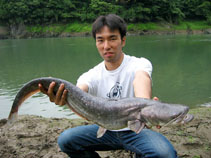http://www.fishbase.org/Summary/speciesSummary.php?genusname=Silurus&speciesname=biwaensis ---> http://192.134.151.83/Summary/speciesSummary.php?genusname=Silurus&speciesname=biwaensis
http://192.134.151.83/Summary/speciesSummary.php?genusname=Silurus&speciesname=biwaensis ---> https://fishbase.mnhn.fr/Summary/speciesSummary.php?genusname=Silurus&speciesname=biwaensis
https://fishbase.mnhn.fr/Summary/speciesSummary.php?genusname=Silurus&speciesname=biwaensis ---> https://fishbase.mnhn.fr/summary/Silurus-biwaensis.html
Silurus biwaensis, Eurasian catfish : gamefish

You can
sponsor
this page
Common name (e.g. trout)
Genus + Species (e.g. Gadus morhua)
-

-
About this page
-
Languages
-
User feedbacks
-
Citation
-
Uploads
-
Related species
-


 Eurasian catfish
Upload your
photos
and
videos
Eurasian catfish
Upload your
photos
and
videos
Pictures
|
Google image
 Silurus biwaensis
Silurus biwaensis
Picture by
Jean-Francois Helias / Fishing Adventures Thailand
Teleostei (teleosts) >
Siluriformes
(Catfishes) >
Siluridae
(Sheatfishes)
Etymology:
Silurus:
Greek, silouros = a cat fish + Greek, odous = teeth (Ref.
45335
)
.
Environment: milieu / climate zone / depth range / distribution range
Ecology
Freshwater; demersal. Temperate
Asia: Endemic to Lake Biwa, Japan.
Size / Weight / Age
Maturity: L
m
?
range ? - ? cm
Max length : 118 cm TL male/unsexed; (Ref.
40637
); max. published weight: 17.2 kg (Ref.
40637
)
Largest species among the Japanese silurid fishes (Ref.
37518
).
Life cycle and mating behavior
Maturity
|
Reproduction
|
Spawning
|
Eggs
|
Fecundity
|
Larvae
Based on observations, a female first searches for a spawning site, with a male following behind. Immediately the female stops, the male first places his head under that of the female and then, by bending his body towards her anal fin, positions himself such that his tail is towards the end of the female's snout. From this position, the male then begins to wrap his tail around the head of the female, gradually winding his body tighter and moving along the body of the female until positioned at the center of her body. The male then winds his body tightly around the dorsal side of the female's abdomen for 20-30 seconds. The female then shakes her head from side to side several times, and orientates her body downward. This behavior causes the male to become separated from the female. Immediately after separation, the female releases a large number of eggs, and circles around with the male following on the inside. Although gamete release by the male was not actually observed, it seems likely that the eggs are fertilized during circling. After circling, the pair turns round twice violently, causing the eggs to become widely scattered. The pair then swim away with the female in the lead.
Kobayakawa, M.
, 1989. Systematic revision of the catfish genus
Silurus
, with description of a new species from Thailand and Burma. Jap. J. Ichthyol. 36(2):155-186. (Ref.
9417
)
IUCN Red List Status (Ref.
130435
)
Not Evaluated
CITES
Not Evaluated
Not Evaluated
Threat to humans
Harmless
Human uses
Gamefish: yes
FAO - Publication:
search
|
FishSource
|
More information
Countries
FAO areas
Ecosystems
Occurrences
Introductions
Stocks
Ecology
Diet
Food items
Food consumption
Ration
Common names
Synonyms
Metabolism
Predators
Ecotoxicology
Reproduction
Maturity
Spawning
Spawning aggregation
Fecundity
Eggs
Egg development
Age/Size
Growth
Length-weight
Length-length
Length-frequencies
Morphometrics
Morphology
Larvae
Larval dynamics
Recruitment
Abundance
BRUVS
References
Aquaculture
Aquaculture profile
Strains
Genetics
Electrophoreses
Heritability
Diseases
Processing
Nutrients
Mass conversion
Collaborators
Pictures
Stamps, Coins Misc.
Sounds
Ciguatera
Speed
Swim. type
Gill area
Otoliths
Brains
Vision
Tools
E-book
|
Field guide
|
Length-frequency wizard
|
Life-history tool
|
Point map
|
Classification Tree
|
Catch-MSY
|
Special reports
Check for Aquarium maintenance
|
Check for Species Fact Sheets
|
Check for Aquaculture Fact Sheets
Download XML
Summary page
|
Point data
|
Common names
|
Photos
Internet sources
AFORO (otoliths) |
Aquatic Commons
|
BHL
|
Cloffa
|
BOLDSystems
|
Websites from users
|
Check FishWatcher
|
CISTI
|
Catalog of Fishes
:
genus
,
species
|
DiscoverLife
|
ECOTOX
| FAO - Publication:
search
|
Faunafri
| Fishipedia |
Fishtrace
| GenBank:
genome
,
nucleotide
|
GloBI
|
Google Books
|
Google Scholar
|
Google
|
IGFA World Record
|
MitoFish
|
Otolith Atlas of Taiwan Fishes
|
PubMed
| Reef Life Survey | Socotra Atlas |
Tree of Life
| Wikipedia:
Go
,
Search
|
World Records Freshwater Fishing
|
Zoological Record
Estimates based on models
Phylogenetic diversity index (Ref.
82804
): PD
50
= 0.5001 [Uniqueness, from 0.5 = low to 2.0 = high].
Bayesian length-weight: a=0.00562 (0.00278 - 0.01137), b=3.00 (2.83 - 3.17), in cm total length, based on LWR estimates for this (Sub)family-body shape (Ref.
93245
).
Trophic level (Ref.
69278
): 4.2 ±0.8 se; based on size and trophs of closest relatives
Resilience (Ref.
120179
): Very Low, minimum population doubling time more than 14 years (Preliminary K or Fecundity.).
Fishing Vulnerability (Ref.
59153
): High to very high vulnerability (71 of 100).
Back to Search
Random Species
Back to Top
Accessed through:
Not available
FishBase mirror site :
localhost
Page last modified by :
mrius-barile
- 20 July 2016
Fatal error
: Uncaught ArgumentCountError: Too few arguments to function checkEcotox(), 1 passed in /var/www/html/summary/speciessummary.php on line 2304 and exactly 3 expected in /var/www/html/includes/speciessummary.lib.php:2579 Stack trace: #0 /var/www/html/summary/speciessummary.php(2304): checkEcotox() #1 {main} thrown in
/var/www/html/includes/speciessummary.lib.php
on line
2579
|